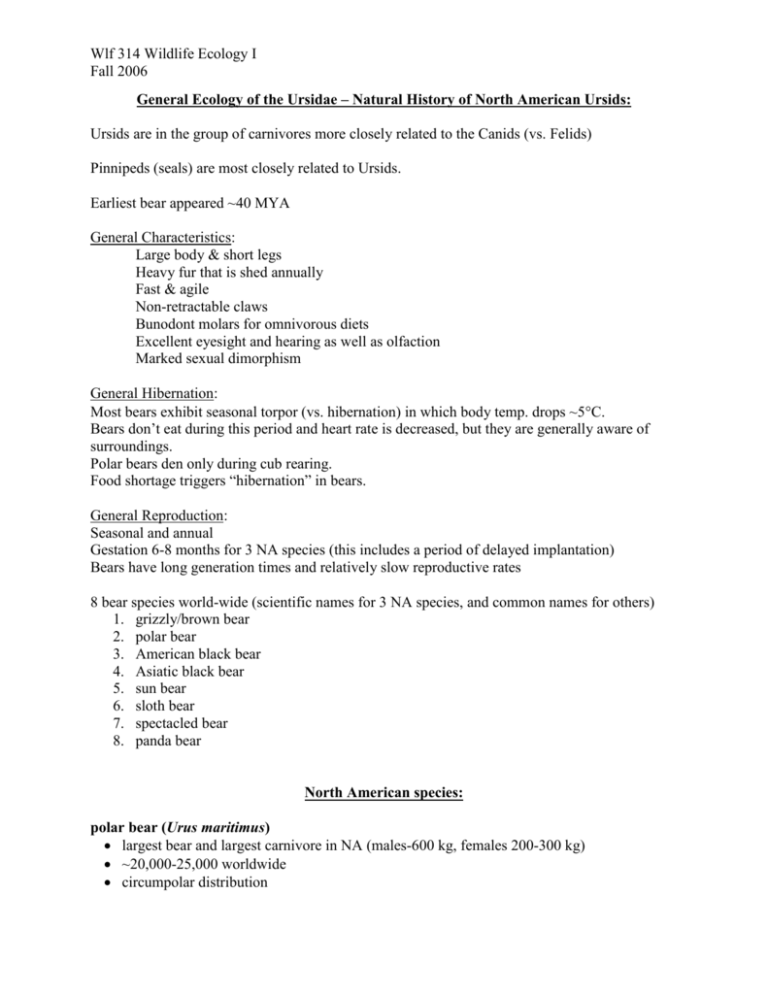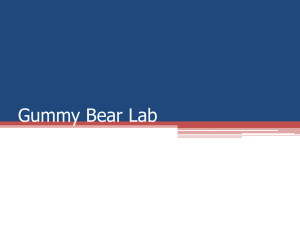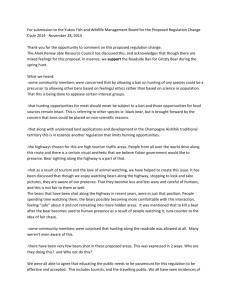General Ecology of the Ursidae – Natural History of North American
advertisement

Wlf 314 Wildlife Ecology I Fall 2006 General Ecology of the Ursidae – Natural History of North American Ursids: Ursids are in the group of carnivores more closely related to the Canids (vs. Felids) Pinnipeds (seals) are most closely related to Ursids. Earliest bear appeared ~40 MYA General Characteristics: Large body & short legs Heavy fur that is shed annually Fast & agile Non-retractable claws Bunodont molars for omnivorous diets Excellent eyesight and hearing as well as olfaction Marked sexual dimorphism General Hibernation: Most bears exhibit seasonal torpor (vs. hibernation) in which body temp. drops ~5C. Bears don’t eat during this period and heart rate is decreased, but they are generally aware of surroundings. Polar bears den only during cub rearing. Food shortage triggers “hibernation” in bears. General Reproduction: Seasonal and annual Gestation 6-8 months for 3 NA species (this includes a period of delayed implantation) Bears have long generation times and relatively slow reproductive rates 8 bear species world-wide (scientific names for 3 NA species, and common names for others) 1. grizzly/brown bear 2. polar bear 3. American black bear 4. Asiatic black bear 5. sun bear 6. sloth bear 7. spectacled bear 8. panda bear North American species: polar bear (Urus maritimus) largest bear and largest carnivore in NA (males-600 kg, females 200-300 kg) ~20,000-25,000 worldwide circumpolar distribution Wlf 314 Wildlife Ecology I Fall 2006 adapted to arctic – dense hair & fat layer (up to 15 cm thick) only pregnant females go into dens summer food is scarce and polar bears may reduce activity during summer will move over vast areas depending on food availability first age at reproduction is often 5-6 years & litter interval averages 3 years polar bears are the only truly carnivorous bear – eat much blubber and often leave meat (which other species like arctic foxes eat) major prey: seals, walruses, beluga whales – summer may include birds, seaweed, lichens, etc. threat from global warming and loss of polar ice sheets brown bear (Urus arctos): ~150,000 worldwide (of which ~ 30,000 in NA) Grizzly bears are one subspecies of brown bear that occurs in Canada, Alaska, and ID, MT, WY most widely distributed of bear species – range includes Asia, Europe, North America males: 125-400+ kg, females 100 – 200+ kg large home ranges – males much larger than HR of females age at first reproduction 3-5 years for females & interval between litters 2-4 years litter size 1-4; average is 2 Omnivorous but more carnivorous than American black bear (vegetation, fish, berries, roots, nuts, as well as deer, moose, ground squirrels, etc.) lifespan 20-30 years American black bear (Urus amricanus) ~625,000-725,000 in NA smallest of 3 NA bear species (males: 60-280 kg; females: 40-100 kg) historically distributed more broadly across NA current distribution from Alaska through Canada and in mountainous/forested areas of lower 48 states (not common in prairie or grassland areas) age of first reproduction 3-4 years for females; interval between litters 2-4 years; litter size 1-4 omnivorous, but rely primarily on vegetation lifespan 20-25 years





